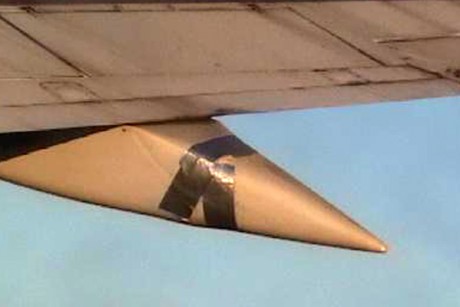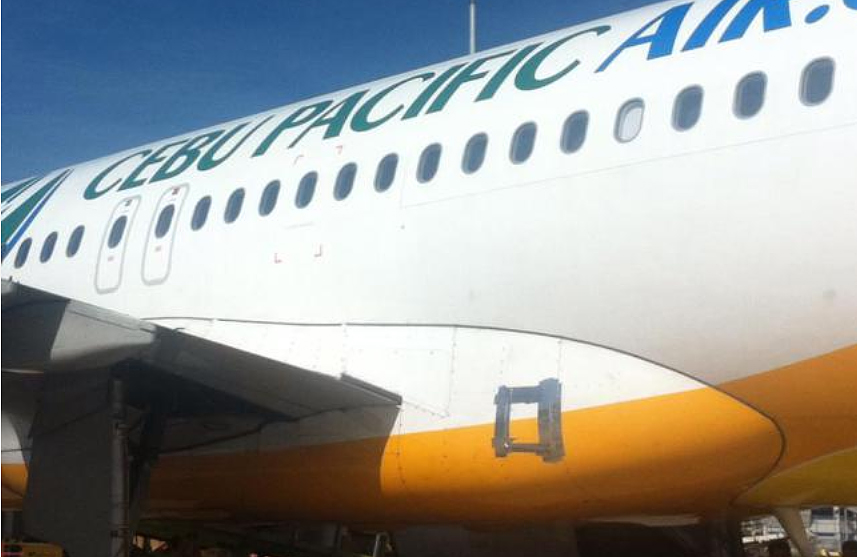Don’t Panic

January 11, 2015
THIS AGAIN: a passenger snaps a picture of what seems to be duct tape affixed to some portion of an airplane, uploads it to Facebook or wherever, and suddenly it’s a scandal.
The picture above, showing tape over the flap fairing of a 737, was sent to me by a panicked reader a few years ago. This week it’s a picture from the Philippines, where a Cebu Pacific Airbus A320 was photographed with a taped-over panel near its port side wing root.

What you’re actually seeing is a heavy-duty aluminum bonding tape known as “speed tape.” It’s a temporary fix and it’s used only on superficial or noncritical components, until more substantive repairs are made later on. The tape is extremely durable and is able to expand and contract through a wide range of temperatures.
“We never use, and don’t even stock, duct tape,” explains a veteran airline mechanic. “Some of the tapes we use cost hundreds, even thousands, of dollars per roll. Speed tape is one of those. Last I heard, it costs about $700 per four-inch wide roll. It’s approved by the manufacturer, FAA and company engineering department for certain repairs — always temporary.”
In the top photo, those canoe-shaped fairings are noncritical. They’re a streamlining device, mainly, that protect the flap extension mechanisms and help smooth the airflow around them. On the Cebu Pacific plane the tape is securing an access panel. Both the fairing and the access panel could be entirely missing with no ill effects on the plane’s ability to fly beyond, perhaps, a minor fuel-burn penalty.
My only gripe is the haphazard way in which the tape is sometimes applied. In both of these pictures it looks as if the mechanic brought his eight year-old son to work and let him give it a try. That’s just begging for controversy, and airline staff should know better. Cockpit crews could help too in these situations through a simple PA announcement.
Damage control becomes difficult once the media or the Internet gets hold of these things. In London in 2011, passengers watched with reported “horror” as a problem with a Ryanair jet’s windscreen was repaired using what they took to be duct or gaffer’s tape. The plane took off for Riga, Latvia, only to return to Stansted Airport twenty minutes later when, according to the UK tabloid Sun, the tape came loose and began making “disturbing noises.” Granted, anything from the Sun is to be taken with a grain of salt, but this story was picked up by Gizmodo — they called it a “taped window shocker” — and other online sites, and pretty soon millions of people were reading about it.
The window tape too was a cosmetic application; it was used to keep uncured sealant in place. By no stretch was it holding the window in place. The taped section was not a stressed area of the windscreen or frame. “The seal around the outside of a cockpit window is strictly an aerodynamic seal,” says the mechanic. “The real, structural seal is deeper inside. This is not an automobile windshield; the actual glass panel is sandwiched between the airframe structure and removable outer heavy stainless steel retainers. The outer, aerodynamic seal is a wet-mixed sealant which smooths the step from the windshield to the retainers. This sealant usually requires about 24 hours to fully cure. If the aircraft needs to fly during that period, it is permissible to apply tape to the outside to protect the sealant during flight. I have seen two different types of tape used: a clear Mylar tape and the aluminum speed tape. The company’s maintenance manual will tell you which kind is permitted, and for how long.”
But what of those “disturbing noises,” and why did the plane return to London? There could have been a minor pressurization leak, or a portion of the tape may have become unstuck. At high speeds a loose strip of tape can create a vibrating “scream” or squeal as it flutters against the airframe. This is harmless, but the crew, unable to see exactly what the problem was — and probably put off by the loud noise — thought it prudent to turn back.
One way or another, Ireland’s Ryanair always manages to find itself in the news. Michael O’Leary, the carrier’s flamboyant CEO, seems to thrive on publicity and controversy. Among O’Leary’s off-the-wall pronouncements, you might recall, was a proposal to lower crew costs by training flight attendants to sit in for the first officer. Cue a caricature of Mr. O’Leary, a big piece of speed tape over his mouth.
Note: Portions of this story originally appeared in the online magazine Salon.
Reprinted with permission from Patrick Smith.
Leave a Reply